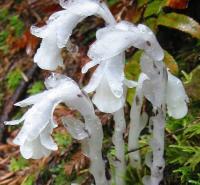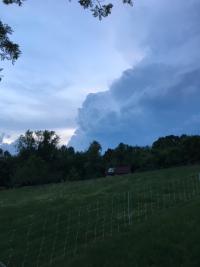 Monotropa uniflora is a small plant, wholly white, a pale translucent flute known as Ghost Pipe or Ghost Plant. It bends at the top and has but a single flower. Without chlorophyll, it cannot create energy as green plants do, from the sun. Instead it draws energy from the fungi that cluster in the roots of trees as they reach into the dark earth. Ghost Pipes appear rarely around here, in the threshold time between spring and summer, albino messengers from another realm. Josh saw a covey of them in the Memorial Grove during his run on a cool misty morning. He was struck by their presence in that place of remembrance, reflecting, “It felt eerie and beautiful all at the same time.”
Monotropa uniflora is a small plant, wholly white, a pale translucent flute known as Ghost Pipe or Ghost Plant. It bends at the top and has but a single flower. Without chlorophyll, it cannot create energy as green plants do, from the sun. Instead it draws energy from the fungi that cluster in the roots of trees as they reach into the dark earth. Ghost Pipes appear rarely around here, in the threshold time between spring and summer, albino messengers from another realm. Josh saw a covey of them in the Memorial Grove during his run on a cool misty morning. He was struck by their presence in that place of remembrance, reflecting, “It felt eerie and beautiful all at the same time.”
At the closing council of the “Restorying the Heroine’s Journey” retreat in early June we were seated within the Meditation Shelter, a small, round building made of ancient stones and timber from the land. Hundreds of wanderers and seekers have gathered here over innumerable seasons. The Shelter is on the site of the geodesic dome where the early Rolling Ridge community met during the exhilarating and arduous days when Rolling Ridge Study Retreat was coming to be. Now, seated on the benches pushed to the encircling wall, it is possible to sense those who have come before and to feel all around the wild ones of the forest: ever present witnesses to our journey here.
In the council, the talking piece was passed from lap to lap with a question spoken from the heart of one into the surprised ears of the next. The question asked of me was, “Lindsay, how does your living prepare you for death?”
I love the poem Coleman’s Bed by David Whyte, which is a call to “apprentice yourself to yourself, begin to welcome back all you sent away, be a new annunciation…” It’s an invitation to live in the crucible of becoming, that grace-fired place where each moment counts:
See with every turning day,
how each season makes a child
of you again, wants you to become
a seeker after rainfall and birdsong,
watch now, how it weathers you
to a testing in the tried and true,
admonishes you with each falling leaf,
to be courageous, to be something
that has come through, to be the last thing
you want to see before you leave the world.
Mary Oliver sighs, “I am so distant from the hope of myself…” Every day has a myriad of tiny stumbles into crevices of distraction and inanity where the horizon slips from view. Yet even as I lurch and tumble, something else is happening. Under the earth, the Ghost Pipes are connected in a complex relationship with mycorrhizal fungi in the soil, which in turn connect with the roots of a living tree. While the Ghost Pipes are mostly parasitic, the mycorrhizal fungi form beneficial symbiotic relationships with the trees, feeding them. This unseen web spreads out through the forest, an immense network of communication and sustenance, connecting everything.
It seems to me that death is the ultimate expression of belonging, that moment when (I imagine) we at last recognize our place in “the family of things”. It is the final breath we take in this realm, a breath that moves us along in the loving dance of reciprocity, of turning and returning. John O’Donohue puts it this way in a prayer for the dying:
[may] Your heart [be] breathless
In the light and lightness
Where each and every thing
Is at last its true self
Within that serene belonging
That dwells beside us
On the other side
Of what we see.
 It turns out that all along we’ve been part of a vast and timeless communion of saints, of all beings woven together in the Dream of the Earth, possibly of the Universe. No wonder our hearts will be breathless. O’Donohue says, “You are not going somewhere strange. You are going back to the home that you never left.”
It turns out that all along we’ve been part of a vast and timeless communion of saints, of all beings woven together in the Dream of the Earth, possibly of the Universe. No wonder our hearts will be breathless. O’Donohue says, “You are not going somewhere strange. You are going back to the home that you never left.”
The single flowers of Ghost Pipes are pollinated by small bees. The flowers stretch upward and form a seed capsule. After the tiny seeds mature, they are carried throughout the forest by the wind. Once the seeds have been released into the world, the Ghost Pipes wither away and another round of the exquisite, complicated, eternal dance begins.
I glimpse the holy array only rarely, when it is framed by Ghost Pipes, or the candlelit Shelter, the crescent moon, the smile of a friend, the laughter of a grandchild, the gathering storm clouds at sunset, a heron in the mist on Assateague Island. I go imperfectly along, frequently dropping out of the conversation. In this age of overwhelming disruption and interruption it is easy to do, to lose courage and insight. Fortunately ones wiser than I (O’Donohue again) tell me that the point is not heroics, but intention and vulnerability:
…when destiny draws you
into these spaces of poverty,
and your heart stays generous
until some door opens into the light,
you are quietly befriending your death;
so that you will have no need to fear
when your time comes to turn and leave,
that the silent presence of your death
would call your life to attention…
to the urgency to become free
and equal to the call of your destiny.
In the middle of a sunny afternoon I went looking for those Ghost Pipes in the Memorial Grove. I spied only three at the edge of the path just past the old oak, not far from the stone naming Paul and Ellen Peachey, founders of the story that flows on at Rolling Ridge. The Ghost Pipes nodded there, drinking in tree root energy in a place that harbors memory, grief, and transformation: tiny sentinels of mystery and communion, calling my life to attention.